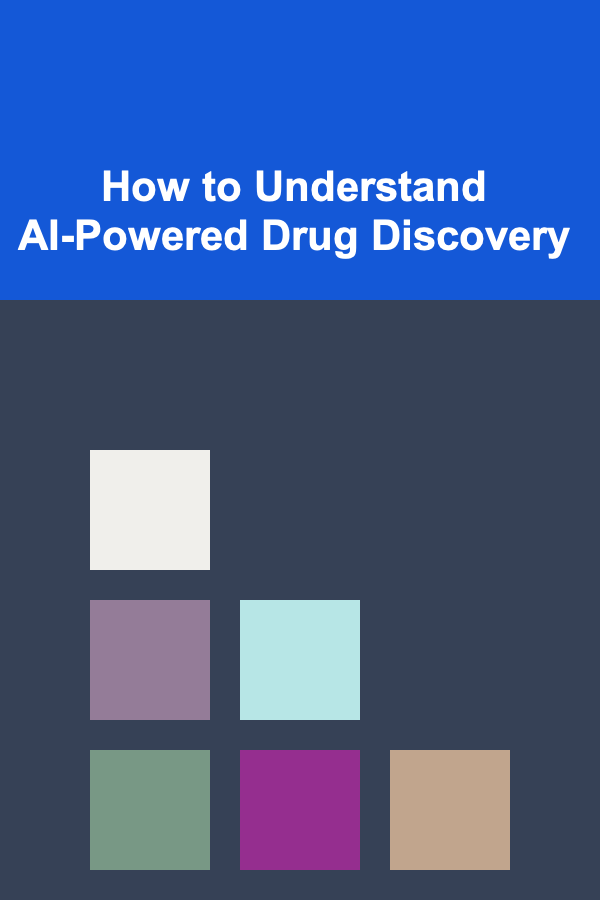
How to Understand AI-Powered Drug Discovery
ebook include PDF & Audio bundle (Micro Guide)
$12.99$5.99
Limited Time Offer! Order within the next:

The discovery of new drugs has always been a complex and lengthy process, traditionally involving years of research, experimentation, and clinical trials. With the emergence of artificial intelligence (AI), however, this process is undergoing a profound transformation. AI-powered drug discovery is revolutionizing the pharmaceutical industry by streamlining and accelerating the development of new medicines. In this article, we will explore the intricacies of AI-powered drug discovery, its key methodologies, benefits, challenges, and its potential to reshape the future of medicine.
The Traditional Drug Discovery Process
Before delving into AI's role in drug discovery, it's important to understand the conventional drug discovery process. Traditional drug development generally follows a series of stages:
- Target Identification and Validation: Scientists identify a biological target (usually a protein or gene) that plays a role in a disease. This step involves understanding the disease's molecular mechanisms.
- Hit Discovery: Researchers screen large libraries of compounds to find those that can interact with the identified target. This stage typically requires high-throughput screening (HTS) and chemical synthesis.
- Lead Optimization: Once "hit" compounds are identified, they are further optimized for their effectiveness and safety. Chemists modify the compound's structure to improve its affinity, stability, and bioavailability.
- Preclinical Testing: The optimized compounds undergo laboratory and animal testing to evaluate their safety and efficacy.
- Clinical Trials: If preclinical results are promising, the drug moves into clinical trials, which are divided into three phases (I, II, and III) before it can be approved by regulatory bodies like the FDA.
- Approval and Market Launch: After successful trials, the drug undergoes regulatory review and is approved for use.
This conventional process can take years, sometimes decades, and cost billions of dollars. However, with AI's involvement, this timeline is shrinking, and the costs are becoming more manageable.
What is AI-Powered Drug Discovery?
AI-powered drug discovery refers to the application of machine learning (ML) and other artificial intelligence techniques to assist in the identification, optimization, and development of drugs. AI can analyze massive datasets much faster and more accurately than humans, allowing researchers to gain insights into complex biological systems that were once inaccessible.
The core of AI-powered drug discovery lies in its ability to:
- Predict biological activity: AI can forecast how certain molecules will interact with biological targets.
- Optimize compounds: AI algorithms can suggest modifications to chemical structures to improve their drug-like properties.
- Analyze vast datasets: AI can analyze enormous datasets from genomics, proteomics, and other omics sciences to identify new therapeutic targets.
By automating much of the trial and error involved in traditional drug discovery, AI can significantly speed up the process and make it more cost-effective.
Key AI Techniques in Drug Discovery
AI-powered drug discovery leverages several key AI techniques. Below are some of the most commonly used methods:
1. Machine Learning (ML)
Machine learning is at the heart of AI-powered drug discovery. ML algorithms learn patterns from data, making predictions or decisions without explicit programming. In drug discovery, ML can analyze large datasets of chemical compounds, genetic information, and biological results to uncover hidden patterns that suggest potential drug candidates.
Supervised learning and unsupervised learning are two of the most common ML techniques used in drug discovery:
- Supervised learning: In this approach, the algorithm is trained on a labeled dataset, meaning the correct answers (e.g., which compounds are effective against a disease) are provided. The algorithm then learns to predict outcomes for new, unseen data.
- Unsupervised learning: Here, the algorithm identifies patterns or structures within data without predefined labels. This is useful for clustering compounds into groups based on shared properties or identifying new therapeutic targets.
2. Deep Learning (DL)
Deep learning, a subset of ML, uses artificial neural networks to model high-level abstractions in data. These networks consist of layers of interconnected nodes that mimic the brain's neurons. Deep learning excels at handling complex, unstructured data such as images, text, and biological sequences.
In drug discovery, deep learning can be used for tasks such as:
- Drug target prediction: Neural networks can analyze genomic data to identify novel targets for drug development.
- Molecular property prediction: Deep learning models can predict the properties of molecules, such as their binding affinity to a target protein or their toxicity.
3. Natural Language Processing (NLP)
NLP is another AI technique that focuses on understanding and processing human language. In drug discovery, NLP is useful for mining scientific literature, patents, and clinical trial reports to uncover new insights.
NLP can automate the extraction of relevant information from millions of scientific papers, making it easier for researchers to stay up to date with the latest findings and identify promising drug candidates or research gaps.
4. Generative Models
Generative models are a class of algorithms that can generate new data instances that resemble a given dataset. In drug discovery, generative models are used to create novel molecular structures that may have desirable properties, such as high binding affinity or low toxicity.
These models are trained on existing chemical datasets and learn to generate new compounds that fit certain criteria. One popular approach is the variational autoencoder (VAE), which can generate new molecular structures that are similar to known drugs but with modifications that may enhance their effectiveness.
5. Reinforcement Learning (RL)
Reinforcement learning is an area of machine learning where an agent learns to make decisions by interacting with an environment and receiving feedback in the form of rewards or penalties. In drug discovery, RL can be used to optimize drug-like properties by rewarding the algorithm when it identifies beneficial modifications to a drug's chemical structure.
For example, RL can be applied to the optimization of drug candidates by rewarding the system for designing molecules that bind strongly to a specific target protein or show low toxicity.
Benefits of AI-Powered Drug Discovery
AI has the potential to transform the drug discovery process in several important ways:
1. Speeding Up Drug Development
One of the most significant advantages of AI in drug discovery is its ability to accelerate the process. Traditionally, the drug discovery process is time-consuming, with each phase taking years to complete. By automating tasks such as compound screening, target identification, and optimization, AI can significantly shorten the timeline from years to months.
2. Cost Reduction
AI can reduce the costs of drug development by streamlining various stages of the discovery process. For example, AI can help identify promising drug candidates early on, reducing the need for expensive and time-consuming clinical trials. Furthermore, AI algorithms can help prioritize compounds with the highest likelihood of success, making the entire process more efficient.
3. Improved Accuracy and Precision
AI models can analyze vast amounts of data with high precision, making predictions about drug efficacy and safety that would be difficult for human researchers to generate. By analyzing complex biological data, AI can help identify the most promising targets, reducing the risk of failure later in the development process.
4. Personalized Medicine
AI-powered drug discovery also enables the development of personalized medicine. By analyzing individual genetic profiles, AI can help design drugs tailored to a person's specific genetic makeup, leading to more effective treatments with fewer side effects.
5. Exploration of New Drug Targets
AI's ability to analyze large datasets from genomics, proteomics, and other biological disciplines opens up new avenues for discovering drug targets. AI can uncover hidden connections between diseases and biological pathways, identifying new targets that were previously overlooked.
Challenges of AI in Drug Discovery
While AI holds great promise, there are several challenges to its widespread adoption in drug discovery:
1. Data Quality and Availability
AI algorithms rely on high-quality data to make accurate predictions. In drug discovery, data can be noisy, incomplete, or inconsistent, which can lead to biased or incorrect results. Ensuring that datasets are comprehensive, clean, and representative is a critical challenge in using AI effectively.
2. Interpreting Results
AI models, particularly deep learning algorithms, can be complex and difficult to interpret. While these models may make accurate predictions, understanding why they make certain decisions can be challenging. This lack of transparency can be a barrier to the widespread acceptance of AI in drug discovery, especially in regulated industries like pharmaceuticals.
3. Integration with Existing Processes
Integrating AI-powered tools into existing drug discovery workflows can be challenging. Many pharmaceutical companies have entrenched processes and systems, and incorporating AI into these processes requires significant changes to infrastructure, training, and workflows.
4. Ethical and Regulatory Considerations
As AI becomes more involved in drug discovery, ethical and regulatory considerations must be addressed. AI algorithms must be transparent and accountable, and there must be clear guidelines regarding their use in drug development. Regulatory bodies like the FDA will need to develop new frameworks for assessing AI-driven drug discoveries.
The Future of AI in Drug Discovery
The future of AI in drug discovery looks promising. As AI algorithms become more advanced and datasets continue to grow, the potential for AI to transform the pharmaceutical industry will only increase. In particular, AI's ability to personalize medicine, predict patient responses, and discover new drug targets will likely be key drivers of future innovation in healthcare.
Additionally, collaboration between AI companies and pharmaceutical giants will continue to evolve. As these partnerships grow, we can expect AI to play an even larger role in the discovery of groundbreaking treatments for a wide range of diseases.
Conclusion
AI-powered drug discovery represents a paradigm shift in the pharmaceutical industry. By leveraging advanced machine learning algorithms and vast datasets, AI can accelerate drug development, reduce costs, and improve the precision and personalization of treatment options. While challenges remain, the potential benefits of AI in drug discovery are immense, and we are likely only at the beginning of a new era in healthcare.
As technology continues to evolve, AI will become an increasingly important tool in the fight against diseases, ultimately improving the quality of life for millions of people worldwide. Through continued innovation and collaboration, AI-powered drug discovery has the potential to reshape the future of medicine, making it faster, more efficient, and more tailored to the needs of individual patients.

How to Avoid Lifestyle Inflation as Your Income Increases
Read MoreHow to Categorize Your Expenses for Better Tracking
Read More
How to Clean Windows Like a Pro
Read More
How to Use a Zero-Based Budget for Household Finances
Read More
How To Leverage Memes and Trends for Engagement
Read More
How to Overcome Self-Sabotage
Read MoreOther Products

How to Avoid Lifestyle Inflation as Your Income Increases
Read MoreHow to Categorize Your Expenses for Better Tracking
Read More
How to Clean Windows Like a Pro
Read More
How to Use a Zero-Based Budget for Household Finances
Read More
How To Leverage Memes and Trends for Engagement
Read More